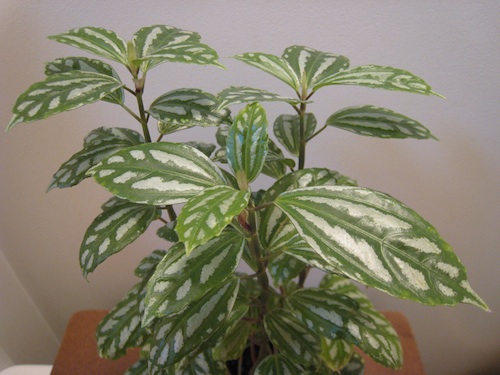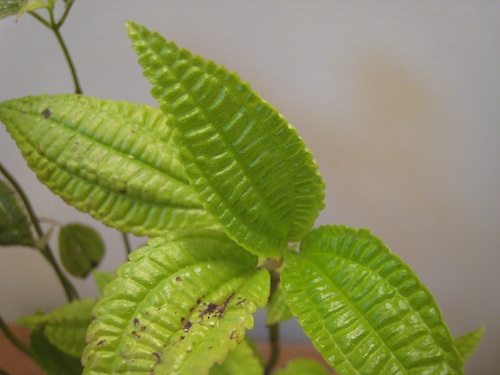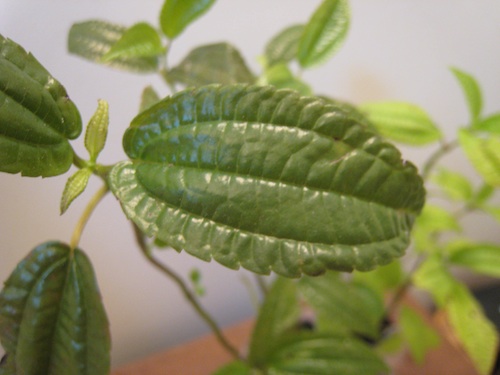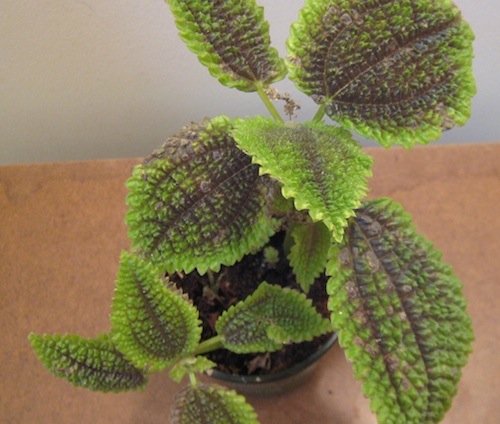| Houseplants are routinely classified into two categories: foliage or flowering. A flowering plant bears beautiful showy blossoms, and also can have lovely leaves. A foliage plant never has lovely blossoms, so it must have beautiful leaves to warrant being grown. No Pilea plant has lovely flowers; few in the genus have lovely leaves; and in the realm of cultivated houseplants, they have been estimated at less than 1 per cent of the foliage plant market --so they are relatively unimportant. |
| Pilea is a plant genus related to the familiar stinging nettle (Urtica species). Pilea differs in growing in tropical, subtropical and warm-temperate regions, wherein it is widespread except for Australasia, and is pleasingly devoid of stinging hairs. Pilea is the largest genus in the nettle family, with some 600 to 715 species. According to the world expert on the genus, Alex K. Monro, "almost all are nondescript understory herbs of minimal economic use." |
| A comparatively tiny number have been grown as ornamental houseplants. As a group, these houseplant species grow slow, are small, devoid of winsome floral beauty or fragrance, and are prized almost only for their attractive foliage of opposite leaves. The flowers and fruits of Pilea are markedly tiny and usually dull looking. Most are creamy colored, now and then pink or red. |
| Related genera include Boehmeria, Pellionia, Elatostema, Soleirolia. |
| The 1821 name Pilea was derived from the Latin pileus, a felt cap, because of the hoodlike calyx partly covering the female flower and fruit. J.C. Traupman's 1966 Latin dictionary entry for pileus reports: "worn by Romans at festivals, especially at the Saturnalia, and given to a slave when freed as a symbol of his freedom; hence the word can symbolize freedom or liberty." |
| Inasmuch as I knew that cold-hardy members of the nettle family, such as Urtica, Parietaria and Soleirolia, were considered edible (albeit utterly bland flavored), I set out to learn about Pilea. As expected, various written sources describe some Pilea species as being eaten as vegetables, and none are noted as poisonous, therefore warranting experimenting with due diligence. In general, the tender young leaves are eaten, because older leaves can become gritty due to cystoliths. |
| Therefore I acquired 6 kinds of Pilea, and in this article show photos, and briefly describe them, and their flavors. Incidentally I mention several other kinds that are either already grown as houseplants, or warrant testing because of their larger leaves of reported edibility. |
| Regarding cultivation of Pilea as houseplants, most prefer warm temperature (winter minimum 50 degrees F); ideally, 75 to 85 during day, 65 to 70 at night. They need humidity; while actively growing, they must be given sufficient water or their leaves will scorch. They should be kept out of direct sunlight. They are brittle and weak, so need protection from clumsy people, wagging dog tails, and the like. They thrive in greenhouse or terrarium conditions. |
If you look into houseplant books, or search online about Pilea, it is quickly clear that name confusion and misidentification prevails more than usual. To discover certainty always requires patience, is sometimes arduous, and is never without one source or another contradicting the matter. Some Pilea plants such as Moon Valley or Silver Tree can be found assigned under 4 or more different specific names!
|
| Pilea Cadierei Gagnep. & Guillaum. 1939 |
| Aluminum Plant. Watermelon Pilea. |
| This species was named to commemorate the talented Léopold-Michel Cadière (1869 - 1955), who collected it in Vietnam, in 1938. Hence the French name Piléa du Père Cadier. The name is sometimes spelt Cardierei. The species also grows in Kweichow (Guizhou), and Yunnan, China. |
| Of all Pilea houseplants, this one has proved over the years the most popular species. It grows straight upright, 10 to 16 inches tall. The leaves measure up to 3.5 inches long, are narrow, thin, with bumpy silvery rows that cause it to be called the aluminum plant or watermelon Pilea. With age, it becomes leggy, losing its youthful lushness, bears its tiny flowers, and then is usually cut back to resprout. |
| I found, in tasting young leaves, they were chewy, bland, and mildly astringent. |
Its cultivar 'Minima' ('Nana') is smaller, only about 6 to 8 inches high, with leaves only to 2 inches. A rarer cultivar, according to Glasshouseworks, is 'Minima Patti's Gold': "Subtle splotches of honey yellow sometimes turn soft cream or pale lime on the already silver-pillowed leaf surfaces as they mature. A remarkable selection by Patti Lee for all collectors of variegates."
|
| Pilea depressa (Swartz) Blume 1856 |
| Creeping Jenny. Shiny Creeping Charley (Charlie). Baby Toes. Giant Baby Tears. Miniature Peperomia. |
From the West Indies, a succulent, small-leaved groundcover, recalling P. nummulariifolia but with smaller leaves --mostly less than half an inch long.
|
| Pilea glaberrima (Bl. 1826) Bl. 1856 |
A robust small shrub from NE India, and China to Indonesia. Not in Western commerce except via seeds for sale now & then. In parts of India and Java --likely elsewhere, too-- the tender young leaves are eaten raw or cooked. Leaves up to 14 inches long.
|
| Pilea grandifolia (L. 1759) Blume 1856 |
| Jamaica Pilea. Maroon Bush. |
| From Jamaica in montane rain forests. A bushy herb to 5 feet tall with glossy leaves to 8 inches long. I bought two clones from Glasshouseworks: 'Coral' (the Copper Pilea) and "Grandis" (the typical version). |
I found, in tasting young leaves, those of the typical form were celery-flavored, mildly bitter, and a bit astringent. The Coral form was inferior.
|
| Pilea involucrata (Sims 1824) C.H. Wright & Dewar 1894 |
| = P. Bertertonia hort. |
| = P. crassifolia (Willd. 1805) Bl. 1856 misapplied |
| = P. mollis Wedd. 1855 |
| = P. pubescens Liebm. 1851 misapplied |
| = P. Spruceana Wedd. 1869 misapplied |
| Panamiga / Panamigo. Moon Valley Pilea. Friendship Plant. |
| From the West Indies, Panama, south to northern S America. Cultivated since 1895 . . . if not earlier. Variable: trailing to upright and 5 feet tall; rough or soft to the touch; leaves egg shaped, toothed, veiny, bronzy-green on top, purplish below, up to 6 inches long. The original Pan-American Friendship Plant (to 8 inches tall; wider still; deeply quilted leaves, almost circular, up to 3 inches; above dark green coppery colored, beneath deep purple. Tiny pink flowers), is not much sold anymore --the more popular form since around 1970 is 'Moon Valley' (see below). |
Two cultivars ascribed to this variable species include:
|
| 'Moon Valley' Introduced about 1969 in England. More upright than the original Panimiga, to 12 inches; Leaves very puckered, quilted apple-green, to 4 inches long, with bronzy-brown veins, serrated edges, sometimes with center chocolate blotch. Costa Rican. |
I found, in tasting young leaves, they were chewy and bland.
|
'Norfolk' or "Angel Wings" is also from England, about 1970; compact, dense; leaves broad, black to dark green, with two curved raised silver bands.
|
| Pilea melastomoides (Poir. 1816) Wedd. 1854 |
| Sweet Nettle. |
From India, China, Taiwan, Indonesia, Sri Lanka, Myanmar, Vietnam. Not in Western commerce except via seeds for sale now & then. As with the Jamaican P. grandifolia, this is a large, shrubby species, the leaves up to 9 inches long. Its young leaves have an aromatic flavor, and are used in seasoning.
|
| Pilea microphylla (L. 1759) Liebm. 1851 |
| = P. muscosa Lindl. 1821, nom. illeg. |
| Artillery Plant or Weed. Gunpowder Plant. Military Fern. Pistol Plant. Rockweed. Lace Plant. |
| From the SE United States; Mexico; the West Indies; Central America; tropical South America; Pacific Islands (Hawaii); Asia. Widely naturalized in subtropical and tropical areas of the world; also a greenhouse weed. Cultivated since 1793 in Europe. The generic type species. |
| Mansfeld's encyclopedia of agricultural and horticultural crops: "Cultivated as a magic, medicinal and ornamental plant in Cuba and Maya home-gardens of eastern Yucatan." |
| A tiny-leaved, ferny-appearing annual, biennial or short-lived perennial. It grows up to 15 inches high; leaves at most five-eighths of an inch long --usually much smaller; flowers a mere 1 / 72 nd of an inch wide. The male flowers, when mature, "shoot" forth like artillery their pollen, likened to gunsmoke. Though the flowers are minuscule, the force of their release is disproportionate, so their pollen can rocket 18 inches away. |
| I found, in tasting young leaves, they were gratifyingly succulent, and flavored with a hint of wintergreen. Definitely the most pleasing of the 5 Pilea that I ate. |
| Two cultivars are: |
| 'Prostrata' the "Waterfall Fern" has prostrate stems with tiny leaves; a weeping effect when used in hanging baskets. |
| 'Variegata' ('Confetti'); the "Snow-Tipped Artillery Plant" has white toned new teardrop leaves foiled by darker foliage below. |
(A similar minikin-leaved species is Pilea serpyllacea (Kunth 1817) Liebm. 1851 'Stoplight'. Sold as Mexican Artillery-Plant --though native in Venezuela, Bolivia, Colombia, Ecuador, and Peru.)
|
| Pilea nummularifolia (Sw. 1787) Wedd. 1852 |
| Creeping Charlie (Charley). |
From the West Indies, Panama to Peru; a low plant suitable for hanging baskets. Bright green leaves nearly orbicular, to three fourths of an inch.
|
| Pilea peperomioides Diels 1912. |
| Chinese Money Plant. Chinese Missionary Plant. Parasol Pilea. |
| Cultivated in Europe since a Norwegian missionary, Agnar Espegren, brought it to Norway from Kunming, Yunnan, China in 1946. Very rare in the wild, and possibly endangered, it grows in limestone rock areas of shaded moist forests. In foliage it is the oddest, most dissimilar Pilea; likely it is also more cold-tolerant and easier as a houseplant. |
| With its roundish leaves (up to 3.5 inches), it can be confused with Hydrocotyle and vaguely recalls Coin-Leaf Peperomia" (Peperomia polybotrya). |
Since my plant consists of only one small leaf, I cannot taste it, but do look forward to the experience, some day . . .
|
| Pilea racemosa (Royle 1836) Tuyama 1966 |
| and P. symmeria Wedd. 1856 |
| and P. umbrosa Wedd. 1854 |
Food Plants International (http://foodplantsinternational.com/) reports in Nepal "tender shoots and leaves are cooked as a vegetable."
|
| Pilea 'Silver Tree'. |
| Silver and Bronze Pilea. |
| Caribbean; Silver Tree is a 1957 copyrighted name; the clone is placed variously under the following species: P. Cadierei; P. Spruceana; P. pubescens; P. involucrata . . . |
Leaves slender, very dark, with especially vibrant markings.
|
Cautionary note: If you buy a houseplant, Pilea or other, from a retailer, far more likely than not it had been sprayed with insecticides and fungicides. The eating of its leaves may harm you due to pesticide residue. To minimize risk, wait at least 2 and better yet 3 months after buying the plant, and only taste the new young leaves. Also be aware that the plant may be harmless to most people, yet cause an allergic reaction to you.
Back |

Pilea Cadierei photo by ALJ
|

Pilea grandifolia photo by ALJ
|

Pilea grandifolia 'Coral' photo by ALJ
|

Pilea involucrata Moon Valley photo by ALJ
|

Pilea microphylla photo by ALJ
|

Pilea peperomioides leaf photo by ALJ
|

